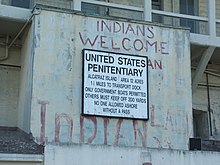Occupation of Alcatraz

The occupation of Alcatraz was an occupation of Alcatraz Island by the group Indians Of All Tribes (IAT). The occupation lasted for nineteen months, from November 20, 1969, to June 11, 1971, and was forcibly ended by the U.S. Government.
Background
According to the IAT, the Treaty of Fort Laramie (1868) between the U.S. and the Sioux returned all retired, abandoned or out-of-use federal land to the Native people from whom it was acquired. Since Alcatraz penitentiary had been closed on March 21, 1963 and the island had been declared surplus federal property in 1964, a number of Red Power activists felt the island qualified for a reclamation.
On March 9, 1964, Richard McKenzie and a small group of other Sioux occupied Alcatraz for four hours.[1] In 1969, Mohawk Richard Oakes and a larger group of activists planned another occupation on November 9. After Adam Fortunate Eagle convinced the owner of the Monte Cristo, a three-masted yacht, to pass by the island, Oakes, Jim Vaughn (Cherokee), Joe Bill (Eskimo), Ross Harden (Ho-Chunk) and Jerry Hatch jumped overboard, swam to shore, and claimed the island by right of discovery.[1] The Coast Guard quickly removed the men, but later that day, a larger group made their way to the island again, and fourteen stayed overnight. The following day, Oakes delivered a proclamation, written by Fortunate Eagle, to the General Services Administration (GSA) which claimed the island by right of discovery, after which the group left the island.
Occupation
On the morning of November 20, 1969, 79 American Indians, including students, married couples and six children, landed on the island (despite an attempted Coast Guard blockade) and began their occupation.[2]
The stated intention of the occupation was to gain Indian control over the island for the purpose of building a center for Native American Studies, an American Indian spiritual center, an ecology center, and an American Indian Museum. The occupiers specifically cited their treatment under the Indian termination policy and they accused the U.S. government of breaking numerous Indian treaties.
Richard Oakes sent a message to the San Francisco Department of the Interior:
We invite the United States to acknowledge the justice of our claim. The choice now lies with the leaders of the American government - to use violence upon us as before to remove us from our Great Spirit's land, or to institute a real change in its dealing with the American Indian. We do not fear your threat to charge us with crimes on our land. We and all other oppressed peoples would welcome spectacle of proof before the world of your title by genocide. Nevertheless, we seek peace.[2]
President Richard Nixon's Special Counsel Leonard Garment took over negotiations from the GSA.[2]
On Thanksgiving Day, hundreds of supporters made their way to Alcatraz to celebrate the occupation.[2] In December, one of the occupiers, Isani Sioux John Trudell, began making daily radio broadcasts from the island, and in January 1970, occupiers began publishing a newsletter. Joseph Morris, a Blackfoot member of the local longshoreman's union, rented space on Pier 40 to facilitate the transportation of supplies and people to the island.[2]
Grace Thorpe, daughter of Jim Thorpe (Sac and Fox), was one of the occupiers and helped convince celebrities like Jane Fonda, Anthony Quinn, Marlon Brando, Jonathan Winters, Buffy Sainte-Marie and Dick Gregory, to visit the island and show their support.[2][3] Rock band Creedence Clearwater Revival supported the occupation with a $15,000 donation.[2]
Collapse and removal
On January 3, 1970, Richard Oakes's 13-year old stepdaughter Yvonne fell to her death, prompting the Oakes family to leave the island.[2] Some of the original occupiers left to return to school, and some of the new occupiers had drug addictions. Some non-aboriginal members of San Francisco's drug and hippie scene also moved to the island.[2]
By late May, the government had cut off all electrical power and all telephone service to the island. In June, a fire (of disputed origin) destroyed numerous buildings on the island.[2] Left without power, fresh water, and with little food, the number of occupiers began to dwindle. On June 11, 1971, a large force of government officers removed the remaining 15 people from the island.[2]
Though fraught with controversy and forcibly ended, the occupation is hailed by many as a success for having attained international attention for the situation of native peoples in the United States.[4]
Legacies
Some 50 of the Alcatraz occupiers traveled to the East Bay and began an occupation of a Nike Missile installation located in the hills behind the community of Kensington in June 1971. This occupation was ended after three days by a combined force of Richmond Police and regular US Army troops from the Presidio of San Francisco.[5] Moreover, the occupation greatly influenced the American government's decision to end its policy of termination pass the Indian Self-Determination and Education Assistance Act of 1975.[2]
The occupation led to an annual celebration of the rights of indigenous people, Unthanksgiving day.
References
- ^ a b Landings 1964 and 1969, Alcatraz is not an island, PBS
- ^ a b c d e f g h i j k l Occupation 1969, Alcatraz is not an island, PBS
- ^ Zinn, Howard (2003), A people's history of the United States: 1492-present, New York, NY: HarperCollins Publishers, Inc., p. 528, ISBN 0-06-052842-7
- ^ Blue Cloud, Peter (1972). Alcatraz Is Not An Island. Berkeley: Wingbow Press. p. 107.
- ^ Berkeley Gazette, June 15-18, 1971
Further reading
- 1969: The Year Everything Changed by Rob Kirkpatrick. Skyhorse Publishing, 2009. ISBN 9781602393660.
- Alcatraz Is Not an Island by "Indians of All Tribes" (Peter Blue Cloud). Berkeley: Wingbow Press, 1972
- Taking Back the Rock, Native Peoples Magazine
